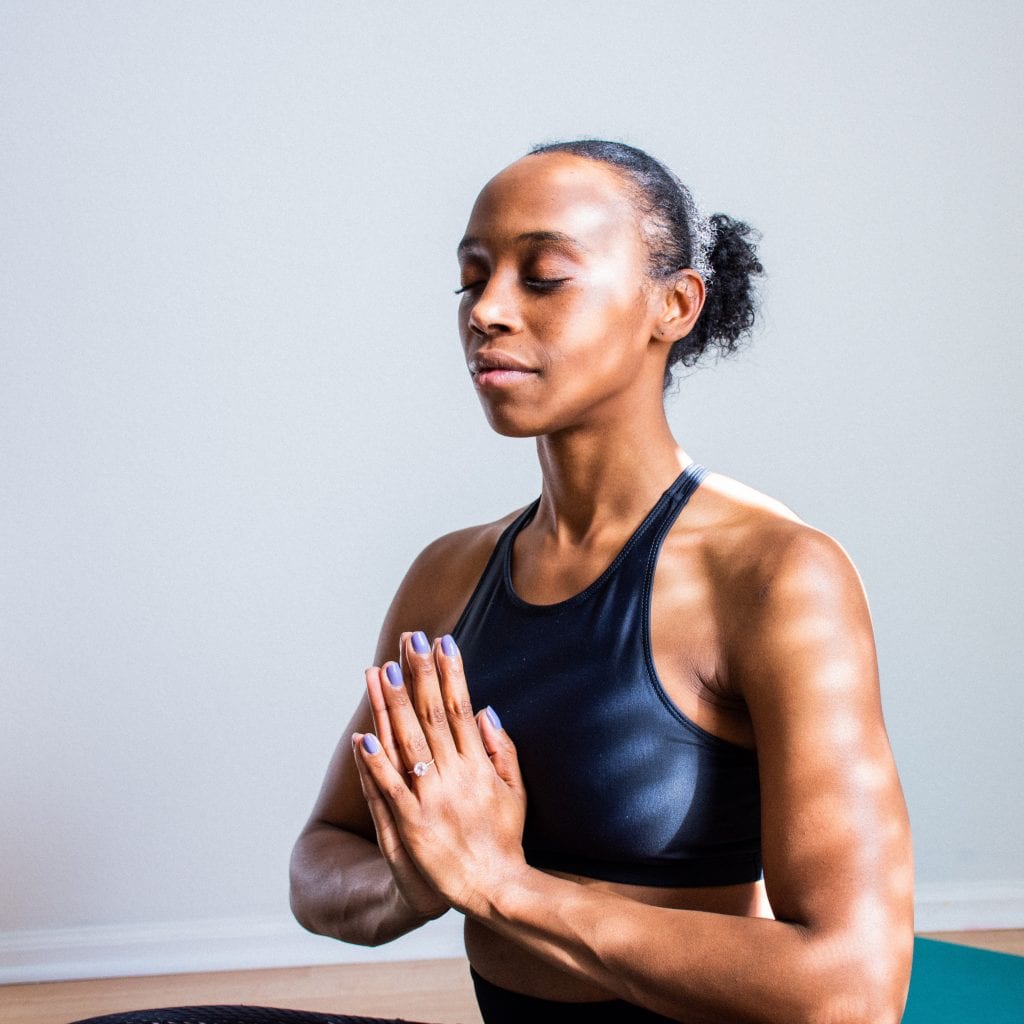Ever feel like you can’t meditate?
That you struggle to concentrate as soon as you close your eyes and sit down on your mat?
If you feel this way, don’t worry, you aren’t alone. In fact, many people struggle with their meditation practice.
Ask any seasoned meditator and they’ll tell you that there are days when you feel like you just can’t meditate.
Days when your mind just wants to wander away like a blood hound on a fox trail.
And while it might be comforting knowing that you aren’t alone, it doesn’t help you make progress with your own practice. So what will?
Why is meditation so hard?
Many people struggle to meditate.
Family commitments, work, little spare time, work stress, too many things on the to do list – sound familiar?
There are lots of things get in the way of your practice. Part of the challenge is learning how to navigate these obstacles and carve out some time to be present. Another part is what to do when you manage to find the time, sit down, and your mind just won’t stop racing!
Here are some common mediation mistakes that are shared among both novice and advanced meditators and simple hacks to move past them.
15 Common meditation mistakes
1. Meditating when you’re tired or hungry
If you’re feeling tired or hungry, your attention is likely already compromised because of your physical state.
Try to begin meditating when you’re feeling alert and physically content, as much as possible.
If you need to have a light snack or get a breath of fresh air before you start your practice, this would be a great time to do so. Try to limit your interruptions, especially those which involve answering calls from your tummy!
2. Trying to meditate in bed
Meditating in bed is very tempting. It’s comfy, warm, and reminds you of relaxing sleep.
Unfortunately, since you’re balancing between a state of relaxation and sleep, it’s very easy to drift off during your practice. To avoid the temptation, avoid meditating while lying down in bed.
If your room is the only place where you have to practice, try sitting upright on a blanket or mat on the floor beside your bed to avoid the temptation to doze off. And if your bed is the only place where you’re comfortable meditating, try keeping your eyes open for the majority of your practice.
3. Committing to long practice intervals
It’s important that you don’t force yourself into long practice intervals. Especially if you’re new to meditation, be sure to find a timeframe that works best for you.
Start with a few minutes and gradually progress from there. If you’re only comfortable practicing for 5 minutes at a time, don’t worry. That’s a great start.
Wherever you are, focus on being there with all of your attention. It’s not the number of minutes or hours of your practice that matters but rather your presence in them.
4. Meditating in front of the TV
One method that is almost guaranteed to cause unnecessary stress and make you believe you can’t meditate is practicing in front of the TV.
This can be done during commercials, while others are watching their favorite shows, and for some even when the TV is turned off. Just being around a television can be distracting.
Give yourself as much space as possible from the TV and any other electronic devices that can steal your attention from the present moment.
5. Trying to block your thoughts
One of the most common challenges beginner meditators face is getting frustrated that they can’t block their thoughts.
They feel as though they can’t meditate because they can’t stop things from passing through their mind.
It’s important to recognize that meditation isn’t about stopping or blocking thoughts. Rather, it’s about being aware of them. Noticing them and without getting carried away with any particular train of thought, just watching it pass by. Sort of like watching trains come and go at a terminal. Train arrives, people scramble around. Train leaves. And you’re still sitting on your bench, noticing all of this, without getting caught up in any of the happenings.

Another common meditation mistake people make is worrying if they’re “doing it right”.
They have all these expectations of what meditation “should be” and what a meditator “should be like” that they caught lost in the mix.
There’s a lot of exposure on meditation and yoga in popular culture which has created a sort of “mindful persona”. A certain look, fashion, and way of being that’s been assigned to mindfulness practitioners. Trying to fit into some kind of “ideal” isn’t going to help you develop your practice. In fact, it’s more likely to make you feel like
7. Giving up too soon
Some of the most widely recognized and medically supported benefits of meditation include:
- reduced stress and anxiety
- improved attention span
- better sleep
- pain management
- increased empathy
- lowered blood pressure
Although meditation has many physical, emotional, and spiritual benefits to offer, these can take time to develop. Another thing to keep in mind is that, not everyone experiences the effects of meditation the same way.
Expecting instant results and having high expectations of what meditation can do for you can add unnecessary pressure and stress.
8. Getting frustrated with yourself
Meditation is a practice and therefore requires… practice!
It takes time before you figure out how to meditate and become comfortable with the process. Getting frustrated with yourself or angry that you aren’t catching on as fast as you’d like certainly won’t help you develop the kind of patience and dedication you need.
Each time that you find your mind wandering, get tired, bored, or skip your practice, instead of getting frustrated, just take a few breaths right then and there. As soon as you have another opportunity, pick up where you started and begin again.
You’re most likely going to experience a few discomforts before your practice begins to feel natural to you. This is completely normal and part of the journey! Embrace it and release the urge to get caught up in your disappointment.
9. Letting distractions ruin your practice
Life is full of distractions.
Family, friends, work, even your home. There’s no shortage of things to take your mind off of your practice.
Whenever you experience a distraction- for example a phone going off, a child crying, a knock at the door, don’t let it “ruin” your practice.
Return to your breathing and tend to whatever you need to do at that moment with your full attention. If you need to turn off a timer, do it with full awareness. Notice how the alarm made you feel, how it influenced your physical body and mental state. How did it affect your breath? Become aware of the muscles you engage to reach for the phone. How it feels in your hand. The feeling that comes to turning off the alarm. And then if you have time, return to your practice.
10. Forcing yourself to sit
For some people, sitting is incredibly uncomfortable. Furthermore, we sit an average of 10 hours per day, making seated meditation practice incredibly unappealing to many people.
You don’t have to sit down to meditate. You can stand, lay down, walk, do yoga, and countless other things. Don’t limit yourself to sitting, especially if you find it uncomfortable or inaccessible to you.
Work with your body, not against it.
11. Expecting instant bliss
If you go into meditation thinking you’re going to experience “instant bliss” or “find your Zen”, you might be a bit let down.
One of the main reasons why people think they can’t meditate is because they aren’t getting what they want out of their practice. Or at least, getting what they think they want out of it.
It takes time, dedication, and a lot of effort to cultivate a lasting meditation practice.
12. Jumping right into practice
A common mistake a lot of people make is to start their practice in a bad mental state and expecting miraculous results.
If you’re having a really bad day or going through some difficult emotions, take a few breaths or go for a short walk before you begin your practice.
You’ll find that it makes for a much easier transition into your meditation than if you just go from experiencing an intense emotion or event (think super stressful meeting or appointment) right to your practice.
This transition doesn’t have to take a lot of time either. Even the process of coming to your mat, laying out your blanket, or positioning your bench can offer the relief you need from your day so that you can align yourself with your practice.
13. Multi-tasking during meditation
How many times have you tried to multi-task during meditation?
Perhaps you’ve created a mental to-do list while sitting, tried to meditate while taking a jog, thought you should start meditating while cleaning the kitchen table as the TV was playing in the background?
Because we feel like we’re chronically low on free time, we try to cram in as many tasks as possible into a single minute. And more often than not, we don’t complete these tasks to the best of our ability because our minds are so preoccupied and running from one thought to the other.
The best way to begin your practice is starting in stillness. If this means that you only have 5 minutes in the morning between getting ready for work and heading out the door, use those moments wisely. Don’t do anything. Instead, focus your attention on being fully present and aware during this time. You can try to sit, stand, or lay down. But for these moments, focus on being stationary to reduce your desire to “do” anything.
As you begin to develop your practice, you might find that you benefit from walking meditation, yoga, or another form of movement. But the point of these exercises, unlike multi-tasking, isn’t to do anything or get anywhere. It isn’t about getting stuff done especially several things at once. Rather, it’s about being fully aware of where you are and in tune with your body.
14. Looking for results
After a few failed attempts, some people believe that meditation is not working for them. Unfortunately, the truth is that meditation practice doesn’t always lead to instant results. More often than not, it takes some time, dedication, and a little effort before you begin to see any signs of progress in your meditation practice.
Additionally, some people have found that meditation stopped work all of a sudden. This could be an incentive to try a different meditation technique, setting, or posture. For example if you’ve found that meditating inside at your desk at work is too challenging, try going outside for a few minutes and practice some walking meditation instead.
Patience is key!
15. Expecting meditation to ‘fix’ something
Why are you engaging in your practice? Is it to achieve something? Perhaps to reduce stress, anxiety, increase happiness? Or to cope with something challenging?
While more and more studies demonstrate the numerous benefits of regular meditation practice, it isn’t a magical cure.
To go into it with the impression that it will somehow “fix” something, be it an affliction, a goal, or some kind of dream might lead to disappointment.



Great content! Super high-quality! Keep it up! 🙂
thnx for sharing this neat website.
tq it is so detailed and it definitely answered all my doubts. thank you